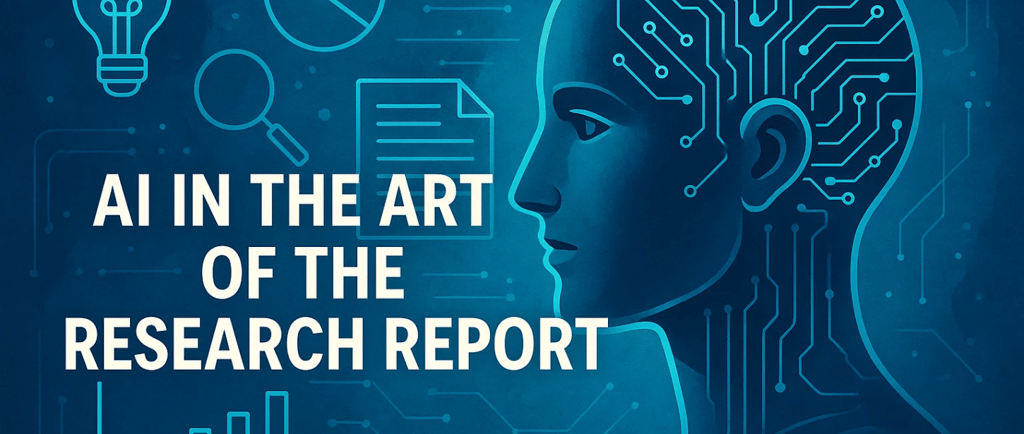Beyond the Hype: How AI is Really Shaping Research Analytics and Reporting
Discover expert guidance and support for students and professionals in financial human resources management. Our experienced professors and consultants provide training and consultation services to inspire growth and advancement in organizations, helping you become a leader in your field.
Ayesha Noor
5/8/20244 min read


In the world of research, we're all too familiar with the data deluge. The sheer volume of information we can now collect is both a blessing and a curse. It holds the promise of groundbreaking insights, but the process of sifting through it all can be a long and arduous journey. Enter Artificial Intelligence (AI), a technology that's been met with a mix of excitement and skepticism. But beyond the buzz, how is AI practically changing the landscape of research, from number-crunching to narrative-crafting?
The truth is, AI is not a magic bullet that will make researchers obsolete. Instead, it's emerging as a powerful and indispensable assistant, automating the tedious and freeing up our minds for the critical thinking and creative insights that only humans can provide. Let's take a look at how AI-driven guidelines, processes, and systems are reshaping both quantitative and qualitative research, and even how we tell the story of our findings.
The New Research Assistant: AI in the Trenches of Data Analysis
AI's impact is being felt across the entire spectrum of data analysis, tackling the unique challenges of both numbers and narratives.
Quantitative Analysis on Overdrive
For those of us who work with numbers, AI, and specifically machine learning (ML), is a game-changer. Imagine being able to identify subtle patterns, hidden correlations, and anomalies in massive datasets that would be virtually impossible to spot with the naked eye. This is where AI excels.
The Process: Instead of manually running endless statistical tests, researchers can now employ AI-powered platforms to perform automated regression analysis, predictive modeling, and cluster analysis. You can feed the system your data, and the AI algorithms will work through it, flagging significant findings and potential areas for deeper investigation.
The Systems: Tools with integrated AI capabilities are becoming increasingly common in statistical software packages. These systems don't just run the numbers; they can also suggest the most appropriate analytical models to use based on the nature of your data.
The Human Touch: The real beauty of this is that it liberates researchers from the mechanical aspects of quantitative analysis. With the heavy lifting of computation taken care of, we can dedicate more of our brainpower to what truly matters: interpreting the results, understanding their implications, and formulating new hypotheses.
Giving Voice to the Data: A New Era for Qualitative Analysis
Qualitative research, with its focus on the nuances of human experience, might seem like an unlikely domain for AI. And it's true, the interpretive heart of this work will always belong to the researcher. However, AI is proving to be an invaluable assistant for handling the more labor-intensive aspects of qualitative data.
The Process: Think about the hours spent transcribing interviews or meticulously coding reams of text. AI, particularly through Natural Language Processing (NLP), can now automate much of this "grunt work." It can transcribe audio with remarkable accuracy, perform initial rounds of coding based on predefined themes, and even conduct sentiment analysis across vast amounts of text from surveys or social media.
The Systems: A new generation of qualitative analysis software now incorporates AI features. These tools can help you visualize connections between themes, identify outlier perspectives, and get a high-level overview of your data, allowing you to dive in with a much clearer sense of direction.
The Human Touch: It's crucial to remember that in the qualitative realm, AI is a guide, not a guru. It can point out potential areas of interest, but it's the researcher who brings the contextual understanding, the cultural sensitivity, and the critical lens necessary to draw meaningful conclusions. The final interpretation and the narrative that emerges remain a fundamentally human endeavor.
From Raw Data to Compelling Narrative: AI in the Art of the Research Report
The journey from data to discovery doesn't end with analysis; we need to communicate our findings effectively. Here too, AI is making its mark, helping us to craft more compelling and accessible research reports.
Data Visualization with a Spark
A picture is worth a thousand words, especially when you're trying to convey complex data. AI-powered tools are revolutionizing data visualization by automatically generating insightful and interactive charts, graphs, and dashboards.
The Process: Instead of wrestling with complex software to create the perfect visualization, you can now use AI tools that analyze your data and suggest the most effective ways to represent it. This makes it easier to not only understand your own findings but also to communicate them to a broader audience, from fellow academics to the general public.
Crafting the Story
While the core arguments and insights of a research report must come from the researcher, AI can be a helpful writing partner.
The Systems: AI-powered writing assistants can help with summarizing key findings, paraphrasing complex sentences for clarity, checking for grammatical errors, and even suggesting ways to structure your report.
Ethical Guidelines are Key: This is where clear guidelines are paramount. The use of AI in writing must be transparent. It's not about letting a machine write your paper, but about using it as a tool to enhance your own writing. The intellectual contribution, the critical arguments, and the narrative thread must be yours and yours alone. Many academic institutions and journals are now establishing clear policies on the acknowledgment of AI tools in research publications.
Navigating the New Frontier: Keeping the Human in the Loop
The integration of AI into the research process is not without its challenges. The potential for algorithmic bias, the "black box" nature of some AI models, and the risk of "hallucinations" (AI-generated misinformation) are all real concerns. This is why the most important guideline of all is to keep a human in the loop.
AI is a powerful tool, but it is just that—a tool. It's up to us, the researchers, to guide its application, critically evaluate its outputs, and ensure that our research remains rigorous, ethical, and intellectually honest. The future of research isn't about human versus machine; it's about the incredible potential that lies in the partnership between human intellect and artificial intelligence. By embracing AI as a collaborator, we can accelerate the pace of discovery and unlock new insights that were previously beyond our reach.
